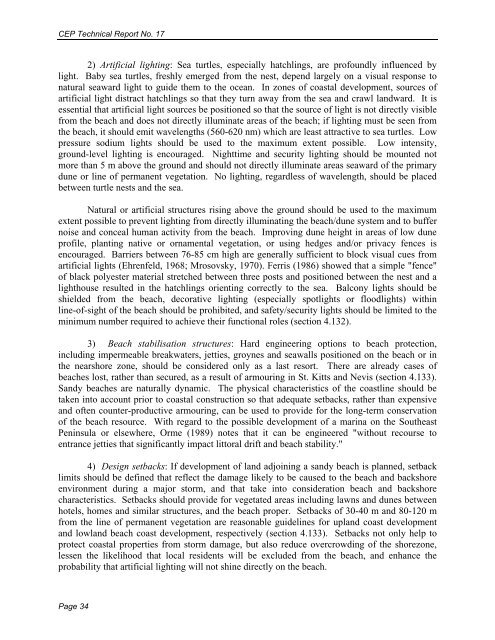Sea Turtle Recovery Action Plan for St. Kitts and Nevis - WIDECAST
Sea Turtle Recovery Action Plan for St. Kitts and Nevis - WIDECAST
Sea Turtle Recovery Action Plan for St. Kitts and Nevis - WIDECAST
Create successful ePaper yourself
Turn your PDF publications into a flip-book with our unique Google optimized e-Paper software.
CEP Technical Report No. 17<br />
2) Artificial lighting: <strong>Sea</strong> turtles, especially hatchlings, are profoundly influenced by<br />
light. Baby sea turtles, freshly emerged from the nest, depend largely on a visual response to<br />
natural seaward light to guide them to the ocean. In zones of coastal development, sources of<br />
artificial light distract hatchlings so that they turn away from the sea <strong>and</strong> crawl l<strong>and</strong>ward. It is<br />
essential that artificial light sources be positioned so that the source of light is not directly visible<br />
from the beach <strong>and</strong> does not directly illuminate areas of the beach; if lighting must be seen from<br />
the beach, it should emit wavelengths (560-620 nm) which are least attractive to sea turtles. Low<br />
pressure sodium lights should be used to the maximum extent possible. Low intensity,<br />
ground-level lighting is encouraged. Nighttime <strong>and</strong> security lighting should be mounted not<br />
more than 5 m above the ground <strong>and</strong> should not directly illuminate areas seaward of the primary<br />
dune or line of permanent vegetation. No lighting, regardless of wavelength, should be placed<br />
between turtle nests <strong>and</strong> the sea.<br />
Natural or artificial structures rising above the ground should be used to the maximum<br />
extent possible to prevent lighting from directly illuminating the beach/dune system <strong>and</strong> to buffer<br />
noise <strong>and</strong> conceal human activity from the beach. Improving dune height in areas of low dune<br />
profile, planting native or ornamental vegetation, or using hedges <strong>and</strong>/or privacy fences is<br />
encouraged. Barriers between 76-85 cm high are generally sufficient to block visual cues from<br />
artificial lights (Ehrenfeld, 1968; Mrosovsky, 1970). Ferris (1986) showed that a simple "fence"<br />
of black polyester material stretched between three posts <strong>and</strong> positioned between the nest <strong>and</strong> a<br />
lighthouse resulted in the hatchlings orienting correctly to the sea. Balcony lights should be<br />
shielded from the beach, decorative lighting (especially spotlights or floodlights) within<br />
line-of-sight of the beach should be prohibited, <strong>and</strong> safety/security lights should be limited to the<br />
minimum number required to achieve their functional roles (section 4.132).<br />
3) Beach stabilisation structures: Hard engineering options to beach protection,<br />
including impermeable breakwaters, jetties, groynes <strong>and</strong> seawalls positioned on the beach or in<br />
the nearshore zone, should be considered only as a last resort. There are already cases of<br />
beaches lost, rather than secured, as a result of armouring in <strong>St</strong>. <strong>Kitts</strong> <strong>and</strong> <strong>Nevis</strong> (section 4.133).<br />
S<strong>and</strong>y beaches are naturally dynamic. The physical characteristics of the coastline should be<br />
taken into account prior to coastal construction so that adequate setbacks, rather than expensive<br />
<strong>and</strong> often counter-productive armouring, can be used to provide <strong>for</strong> the long-term conservation<br />
of the beach resource. With regard to the possible development of a marina on the Southeast<br />
Peninsula or elsewhere, Orme (1989) notes that it can be engineered "without recourse to<br />
entrance jetties that significantly impact littoral drift <strong>and</strong> beach stability."<br />
4) Design setbacks: If development of l<strong>and</strong> adjoining a s<strong>and</strong>y beach is planned, setback<br />
limits should be defined that reflect the damage likely to be caused to the beach <strong>and</strong> backshore<br />
environment during a major storm, <strong>and</strong> that take into consideration beach <strong>and</strong> backshore<br />
characteristics. Setbacks should provide <strong>for</strong> vegetated areas including lawns <strong>and</strong> dunes between<br />
hotels, homes <strong>and</strong> similar structures, <strong>and</strong> the beach proper. Setbacks of 30-40 m <strong>and</strong> 80-120 m<br />
from the line of permanent vegetation are reasonable guidelines <strong>for</strong> upl<strong>and</strong> coast development<br />
<strong>and</strong> lowl<strong>and</strong> beach coast development, respectively (section 4.133). Setbacks not only help to<br />
protect coastal properties from storm damage, but also reduce overcrowding of the shorezone,<br />
lessen the likelihood that local residents will be excluded from the beach, <strong>and</strong> enhance the<br />
probability that artificial lighting will not shine directly on the beach.<br />
Page 34
















